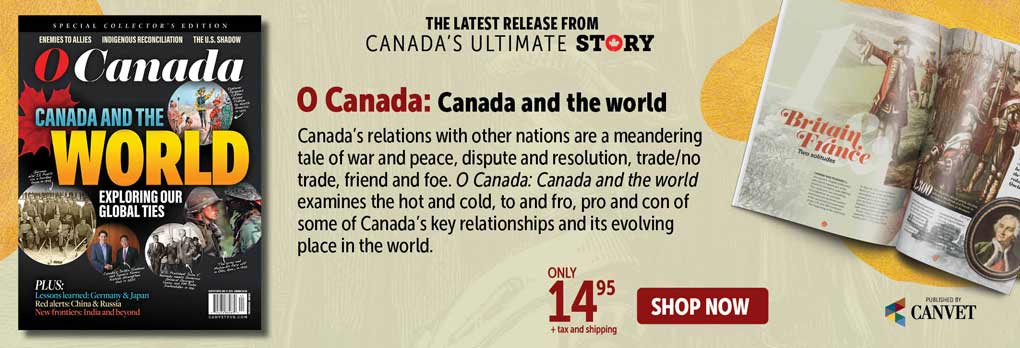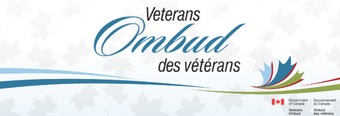
Yousuf Karsh’s Churchill portrait was shot in two minutes in an antechamber off the House of Commons on Dec. 31, 1941. [Yousuf Karsh]
An original print of one of the world’s most famous photographs, stolen during the COVID pandemic, is on its way back to the Ottawa hotel that photographer Yousuf Karsh called home for 19 years.
Pinched from the reading lounge of the Fairmont Château Laurier some time between Christmas Day 2021 and Jan. 6, 2022, and replaced with a fake, the portrait of Britain’s wartime prime minister, Winston Churchill, was found in a private collection in Italy in September 2024.
Jeffrey Wood, 43, of Powassan, Ont., was arrested in April 2024 and charged with multiple offences associated with the picture’s disappearance, including theft, forgery and trafficking in stolen property. His name is under a publication ban.
Working with London bobbies, Ottawa police determined a collector in Genoa had bought the photograph from Sotheby’s auction house for 5,292 British pounds, or about C$9,460, less than half the expected sale price. They emphasized that at the time of the sale, neither party was aware it had been stolen.
The Italian buyer, Nicola Cassinelli, is not a suspect in the case. Acting Detective Sergeant Akiva Geller said the portrait was auctioned before the fraudulent version was discovered among the collection of originals Karsh had gifted the hotel before he moved to Boston in 1997, so they had no reason to suspect it was stolen. Indeed, the phony portrait hung in the hotel for some eight months before the theft was reported in August 2022.
The phony portrait hung in the hotel for some eight months before the theft was reported in August 2022.
A world-class photographer and raconteur, the Turkish-Armenian immigrant became known as Karsh of Ottawa to generations of world leaders, celebrities and cognoscenti. “When the famous start thinking of immortality, they call for Karsh of Ottawa,” journalist George Perry once wrote in London’s Sunday Times.
Karsh’s studio in the Château Laurier, just across the canal from Parliament Hill, became a waypoint for many of the greatest names of the 20th century. And if they couldn’t come to him, Karsh went to them.
Kennedy, Castro, Einstein, Mandela, Hemingway, Schweitzer, Khrushchev. Presidents and prime ministers. Kings and queens. Scientists and doctors. Authors, actors, composers and artists. The list seems endless.
Working primarily in black and white, Karsh’s portraits inevitably captured the essence of his subjects like no other, before or since. And in no portrait, perhaps, is the master’s talent on better display than in his Churchill photograph taken on Dec. 31, 1941, in an anteroom just outside the chambers of the House of Commons.

Karsh’s Churchill portrait appeared on the cover of the May 21, 1945, issue of Life magazine, which purchased the one-time use of the image for $100. [Yousuf Karsh/Life]
In the skies over the home islands and the English Channel, Britain’s “Few” had stopped Hitler’s relentless march across Europe in 1940. But German U-boats were now putting a choke hold on the transatlantic supply line that was the lifeblood of the Allied war effort.
In the weeks leading up to Churchill’s visit, Japan had attacked Pearl Harbor, Hawaii, bringing America into the war, and overrun Singapore and Hong Kong, where some 290 Canadian soldiers were killed and 1,685 captured.
Churchill had come to chart the way forward during an extended stay at the White House with President Franklin D. Roosevelt. He left Washington briefly and took a train to Ottawa, where the British bulldog delivered one of his most famous speeches.
“When I warned [the French] that Britain would fight on alone, their generals (said), ‘In three weeks, England will have her neck wrung like a chicken,’” Churchill told Canadian MPs and guests in the Commons.
“When I warned [the French] that Britain would fight on alone, their generals (said), ‘In three weeks, England will have her neck wrung like a chicken.’”
Ever the master orator, the man who had vowed after France fell in 1940 to “never surrender,” paused. “Some chicken!” he declared. He paused again as the House erupted, then added: “Some neck!”
Afterward, Prime Minister Mackenzie King invited his guest into the Speaker’s antechamber, where Canada’s teetotaling leader sipped tea while the always-ready-to-imbibe Churchill was given a glass of his preferred Johnnie Walker Black Label.
Enter Karsh—a King invitee—who ushered the pair into an adjacent room where lights and camera awaited.
“I switched on my floodlights; a surprised Churchill growled, ‘What’s this, what’s this?’” the photographer wrote. “No one had the courage to explain. I timorously stepped forward and said, ‘Sir, I hope I will be fortunate enough to make a portrait worthy of this historic occasion.’ He glanced at me and demanded, ‘Why was I not told?’
“When his entourage began to laugh, this hardly helped matters for me. Churchill lit a fresh cigar, puffed at it with a mischievous air, and then magnanimously relented. ‘You may take one.’”
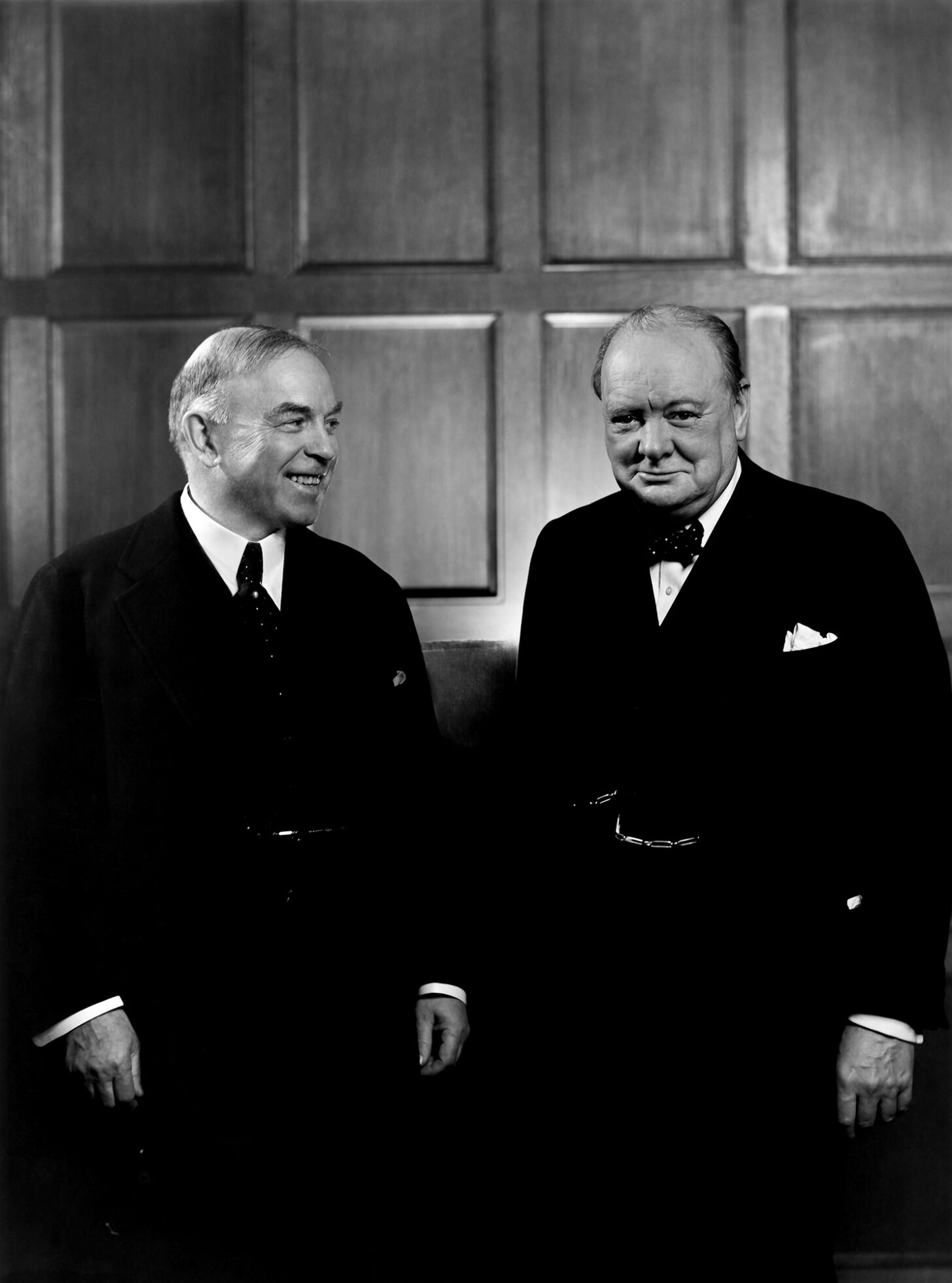
Prime Minister Mackenzie King poses with Churchill during his 1941 visit to Ottawa. [Yousuf Karsh]
“Two minutes were all that he would allow me. Two niggardly minutes in which I must try to put on film a man who had already written or inspired a library of books, baffled all his biographers, filled the world with his fame, and me, on this occasion, with dread.”
Karsh held out an ashtray. The prime minister doggedly refused to co-operate. Karsh checked his camera settings and waited. Churchill continued chomping “vigorously” on his cigar. Karsh waited some more.
“Then I stepped toward him and, without premeditation, but ever so respectfully, I said, ‘Forgive me, sir,’ and plucked the cigar out of his mouth.
“At this the Churchillian scowl deepened, the head was thrust forward belligerently, and the hand placed on the hip in an attitude of anger.”
The image captured Churchill and the England of the time perfectly—defiant and unconquerable.
The photograph appeared on postage stamps in many countries, including Canada, Britain, Australia, New Zealand and the United States.
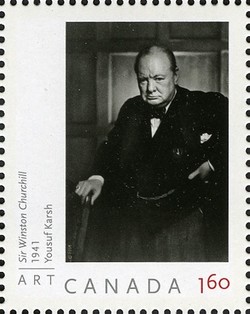
The photograph was reproduced on stamps the world over, including this $1.60 Canadian version from 2008. [Yousuf Karsh/Canada Post]
“My portrait of Winston Churchill changed my life,” Karsh would write. “I knew after I had taken it that it was an important picture, but I could hardly have dreamed that it would become one of the most widely reproduced images in the history of photography.”
The photograph hung in the Château lobby alongside the likes of Karsh’s Albert Einstein, Stephen Leacock, Pablo Casals, Georgia O’Keeffe and others. Nine more Karsh originals—including Ernest Hemingway and George Bernard Shaw—hang in his and wife Estrellita’s former hotel home, now known as the Karsh Suite.
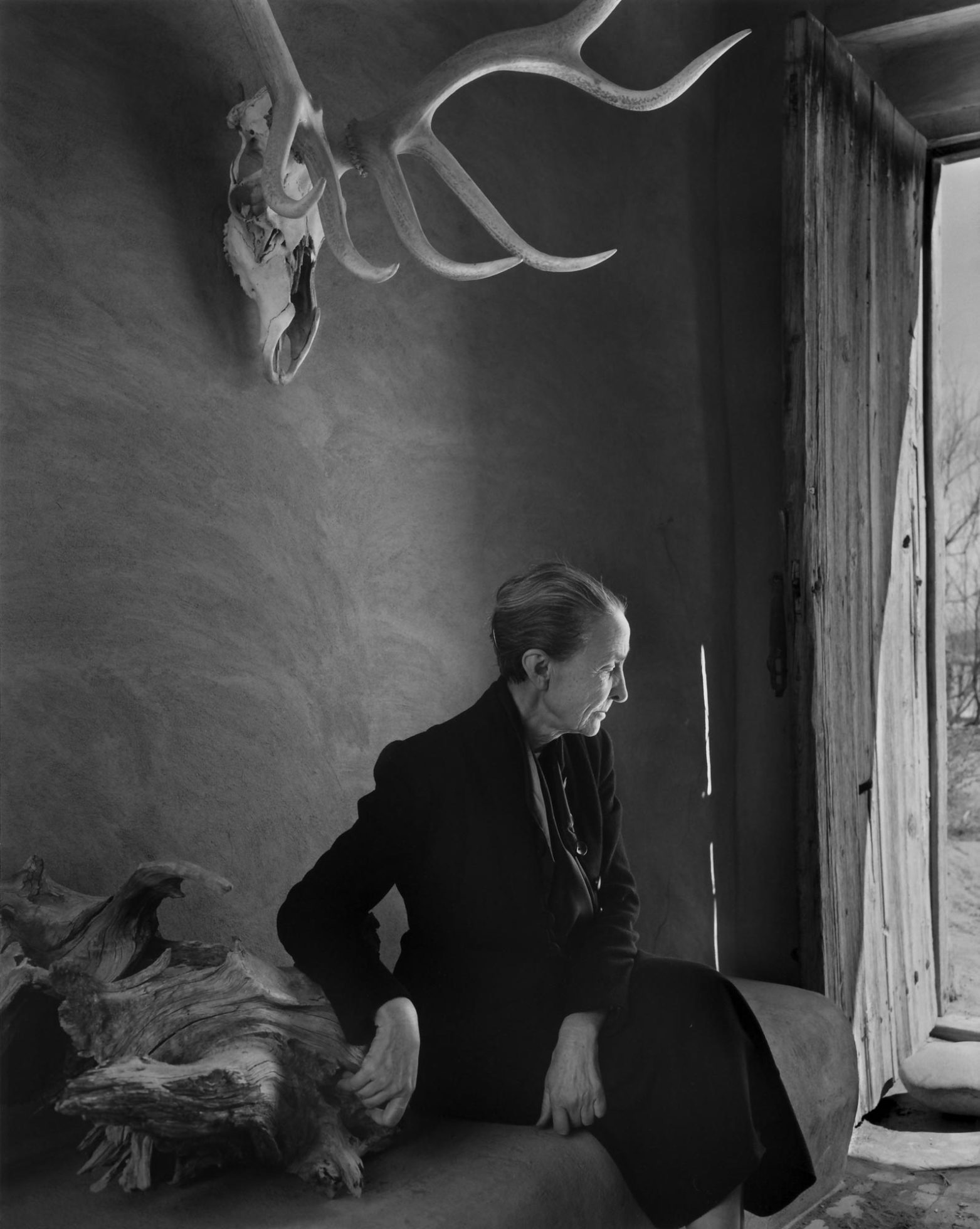
Karsh photographed artist Georgia O’Keeffe as a friend had described her, “her pure profile calm, clear; her sleek black hair drawn swiftly back into a tight knot at the nape of her neck; the strong white hands, touching and lifting everything, even the boiled eggs, as if they were living things.” An original hangs in the reading lounge, soon to be a bar, at the Château Laurier in Ottawa. [Yousuf Karsh]
Hotel general manager Geneviève Dumas said the portrait was expected back in Canada the first week of October 2024. It was to be reframed and examined by a specialist before returning to its rightful place in the Château, possibly as soon as Oct. 28, depending on the status of renovations that are turning the reading lounge into a bar.
Meanwhile, the hotel has upgraded security surrounding its Karsh collection.
Said Dumas: “I want it to stay on the wall this time.”
Advertisement







